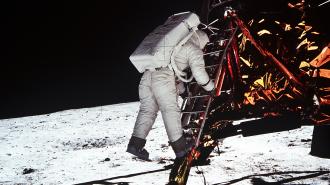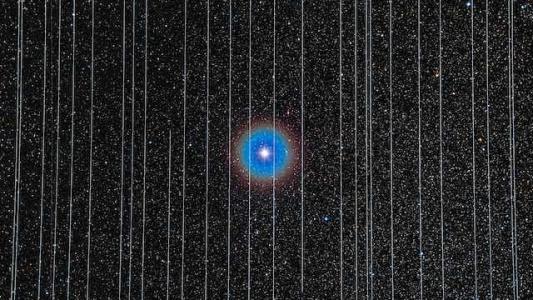Hawaiian engineers are using liquid metal to create a new spacesuit material for NASA — if it works as hoped, it’ll be able to repel dangerous lunar dust that could threaten astronauts.
Lunar dust everywhere: Returning astronauts to the moon is hugely important to NASA. Not only will it enable lunar experiments that would be impossible otherwise, it’ll also give NASA a chance to test out the tech needed to send people to Mars.
“[Lunar] dust is very fine, abrasive, and sharp, like tiny pieces of glass.”
Sharon Miller
As NASA knows from past missions, a major challenge with exploring the moon is that its surface is covered in dust made of tiny, jagged particles of crushed rock. This lunar dust can damage equipment, interfere with instruments, and even slice astronauts’ spacesuits.
“The dust is very fine, abrasive, and sharp, like tiny pieces of glass, making it more of a dangerous threat than just a simple nuisance,” said Sharon Miller, principal investigator of NASA’s passive dust shedding material program, in 2021.
Lunar dust doesn’t behave like Earth dust, either. The dust is heavily exposed to solar radiation, which gives it a positive electrical charge that causes the dust to actively cling to everything, sort of like static.
What’s new? NASA has now awarded Arif Rahman, an assistant professor of engineering at Hawaii Pacific University, a $50,000 grant to build a prototype of a material that could protect astronauts and equipment from lunar dust during future moon missions.
“When activated, it generates an electric field that repels lunar dust.”
Arif Rahman
Rahman calls this material LiqMEST (Liquid Metal Electrostatic Protective Textile), and it will take advantage of the properties of liquid metals to repel lunar dust on demand.
“The technology is designed to be stretchable, and when activated, it generates an electric field that repels lunar dust … This strategy can be applied both to spacesuits and fabric covers for lunar equipment during moon missions,” he continued.
Rahman expects to have his prototype ready for NASA by the end of May 2024. He’ll then apply for another grant to create some product that could be used in space out of the material. Whether that’s a spacesuit, an equipment cover, or something else is TBD.
Looking ahead: Even if LiqMEST works as hoped here on Earth, it’ll need to be certified before NASA could use it for missions. That process will likely take several years, meaning the next astronauts to set foot on the moon (fingers crossed, in 2025) aren’t going to be wearing LiqMEST spacesuits.
The suits they will be wearing will be better than the Apollo-era ones, though.
NASA has teamed up with two companies — Axiom Space and Collins Aerospace — to develop new spacesuits for its upcoming Artemis moon missions, and while they might not be made of liquid metal, they are being specifically designed with dust-resistance in mind.
We’d love to hear from you! If you have a comment about this article or if you have a tip for a future Freethink story, please email us at [email protected].




